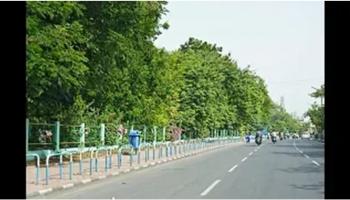Water Management
Energy, environment and waste management - CSR initiatives of ITC Bhadrachalam, Andhra Pradesh
Posted on 28 May, 2009 02:58 PMThis presentation describes the efforts undertaken by ITC Bhadrachalan at water conservation. The company has chosen energy management, environmental & waste management and social & farm forestry as major focus areas for CSR.
Specific processes include recycling/reuse of paper mill back water for dilution of bleached pulp and unbleached tower as well as for pulp slushing; of recausticising plant cooling and sealing water to clarifloculator; reduction in DM water consumption due to increase in process condensate recovery; arresting water piping leakages including fire hydrant piping by clamping; and recycling of paper machine primary clarifier outlet water for miscellaneous uses. Specific water consumption trends show a decrease from 183 cu m/tonne in 1997-'98 to 60.7 cu m/tonne in 2006-'07.
Water conservation initiatives (2007) at GMR Energy Limited, Mangalore
Posted on 28 May, 2009 11:46 AMOperating the world's largest barge mounted power plant off the coast of Mangalore, GMR Energy has a specific water consumption of .126 cu m/MWH, which is less than half the national benchmark of .276 cu m/MWH for such plants.
Water conservation initiatives (2007) at Carrier Aircon, Gurgaon, Haryana
Posted on 28 May, 2009 11:28 AMThis presentation describes the efforts made by Carrier Aircon, Gurgaon at water conservation. This paper and board manufacturer has brought about a reduction in specific water consumption from 173 cu m/MT of paper (2003-04) to 130 cu m/MT of paper (2006-07), while waste water discharge over the same period has come down from 169 cu m/MT to 103 cu m/MT.
Water conservation initiatives (2007) at Mico Bosch, Jaipur, Rajasthan
Posted on 28 May, 2009 11:15 AMThis presentation describes the efforts undertaken by Mico Bosch - Jaipur at water conservation. Water conservation measures taken by this manufacturer of fuel injection pumps for the automotive industry come under the broad heads of reduction in specific water consumption, community partnership & campaigns, and conservation, recycling & auditing.
This, in a larger framework that includes the use of non-conventional energy sources; technology upgradation and increases in usage efficiency; monitoring, auditing and awareness initiatives; resource use minimization and recycling; tree plantation; the minimization of green house gas emissions, vendor/supplier audits and awareness drives for employees and society at large. A zero waste water discharge unit since inception, the plant recycles waste water for both process and gardening needs.
Water conservation initiatives (2007) at Ballarpur Industries Ltd, Yamunanagar, Gurgaon (Haryana)
Posted on 28 May, 2009 11:14 AMThis presentation describes the wastewater management efforts undertaken by Ballarpur Industries Ltd, Yamunanagar, Gurgaon, Haryana. This paper and board manufacturer has brought about a reduction in specific water consumption from 173 cu m/MT of paper (2003-04) to 130 cu m/MT of paper (2006-07), while waste water discharge over the same period has come down from 169 cu m/MT to 103 cu m/MT.
Water conservation efforts (2007) ITC Limited PSPD Unit, Kovai (Tamil Nadu)
Posted on 28 May, 2009 10:34 AMThis presentation describes the water conservation efforts made by ITC Limited, PSPD unit, Kovai, Tamil Nadu. ITC's Kovai unit manufactures paperboard and specialty papers (PSPD). Investments of Rs 30 million in water conservation, Rs.500 million on energy conservation and Rs.150 million on waste utilization have helped this plant achieve many breakthroughs, among them zero effluent discharge and zero solid waste output. 100% of the fly ash from the boiler, sludge from the ETP & plastics from waste is recycled.
The use of waste biomass as the main fuel for the boiler has reduced CO2 emissions by 96,000 tonnes per annum. Under the green belt development activities, vegetation has gone up from 20,000 trees in 2004-'05 to 80,500 in 2006-'07.
Hydrology and water allocation in Malaprabha - comprehensive database and integrated hydro economic model for selected water services in the Malaprabha river basin
Posted on 28 May, 2009 10:26 AM This study by CISED and NIVA aimed at the development of a comprehensive database on the status of water sector and the development of integrated hydro economic model for selected water services in the study area of the Malaprabha basin. The study focused on exploring the feasibility of Payment for Watershed Services (PWS) to improve the water availability through a detailed analysis of the historic hydrologic data and development of a framework of hydrologic and water allocation model. A hydro-allocation model was developed using the software - ArcView SWAT (AVSWAT) and MIKE-BASIN models.
Integrated river basin modeling framework to support payments for watershed services by Norwegian Institute for Water Research (NIVA)
Posted on 28 May, 2009 10:07 AMThis report by NIVA and CISED has been prepared as part of the India-PES initiative, which was a collaborative effort undertaken on a pilot basis, by CISED and NIVA, for the development of integrated tools and consulting services for Watershed Management and 'Payments for Environmental Services' (PES) in India. Tools and methodologies developed as part of this initiative were tested in the Malaprabha river basin in the state of Karnataka, and the PES implementation was focussed on Participatory Irrigation Management.
Panchayati raj and water resources management in India - law and policy
Posted on 27 May, 2009 04:40 PMThis paper presented at the workshop on "Policy Futures for Water Resources Management in India: From prescription and impact assessment to strategic analysis," 3-5 October 2002, IWMI/ICRISAT, Patancheru (Hyderabad), A P, India by
Water law in India - overview of existing framework and proposed reforms (2007)
Posted on 27 May, 2009 04:25 PMThis working paper published on the International Environmental Law Research Centre (IELRC) site maps out the relevant legal framework concerning water in India. The first section delineates water law as it evolved until recently. The second section then examines proposed and ongoing water law reforms that are in the process of completely redrawing India's water legal framework.







